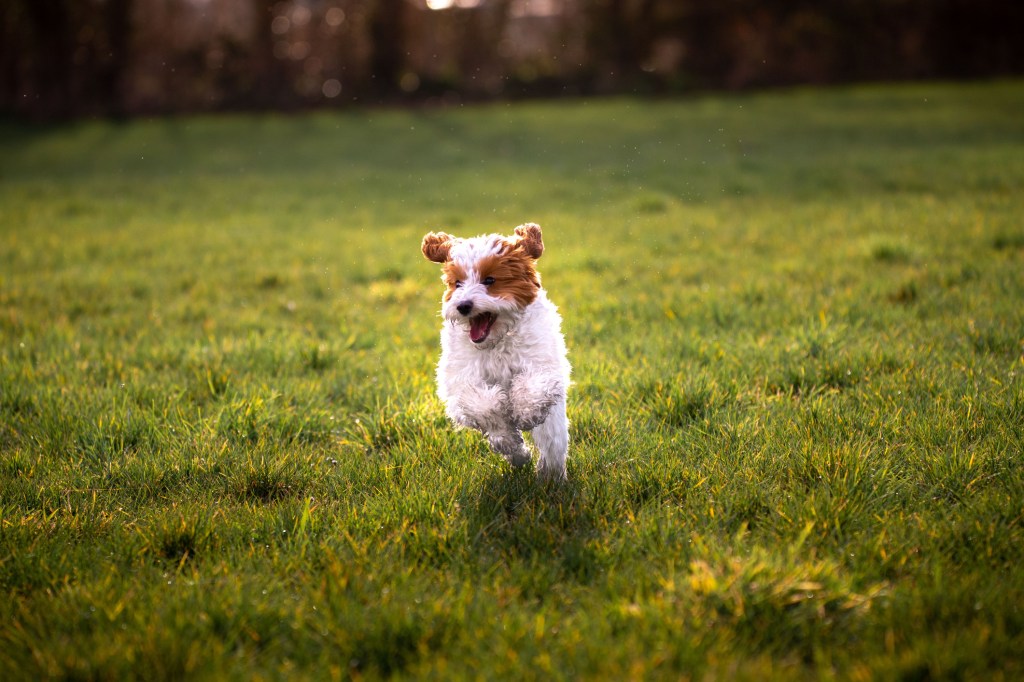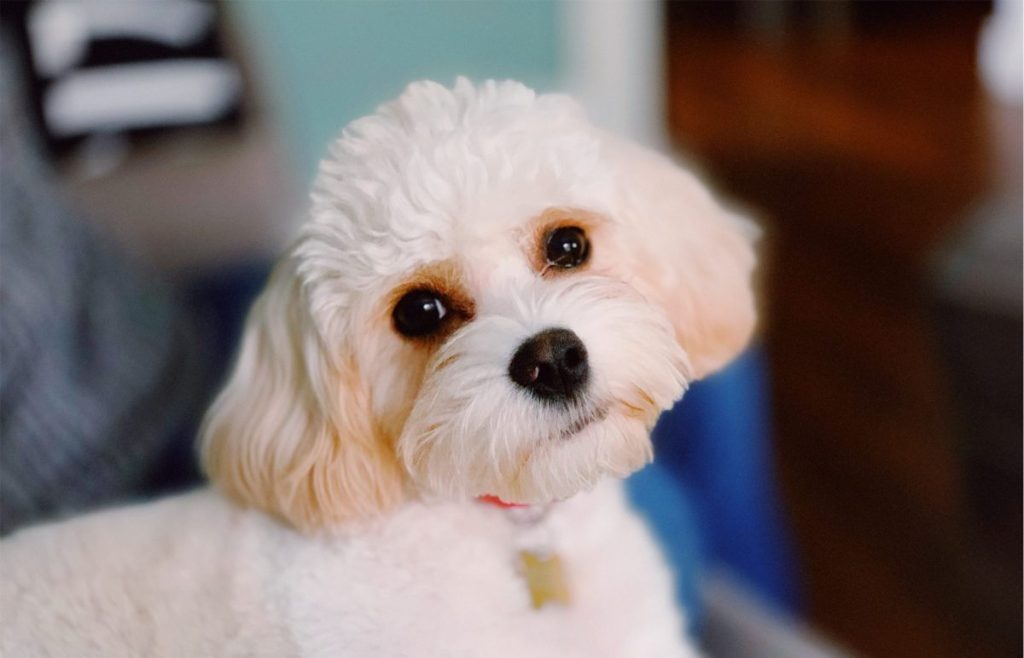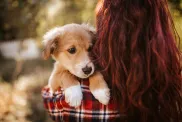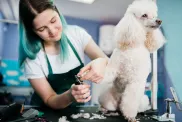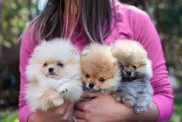The Cavachon is a small-sized companion crossbreed between a Cavalier King Charles Spaniel with a Bichon Frise. Combining the Cavalier’s affectionate nature with the Bichon’s playful demeanor, the Cavachons are beloved for their sweet temperament, intelligence, and irresistible appearance. Sporting a soft, fluffy coat in various colors, including white, apricot, and cream, these affectionate dogs have expressive eyes and floppy ears.
The Cavachon has recently gained popularity for their suitability as a family pet and companion. Specifically, they are known for their adaptability to various living environments, including apartments and houses; Cavachons thrive on companionship and excel in roles as therapy dogs. Lastly, their gentle disposition and friendly nature make them excellent additions to households with children and other pets. At the same time, their intelligence and trainability ensure they are quick learners which is great for first-time pet parents.
Cavachon characteristics
- Height: 12 to 13 inches at the shoulder
- Weight: 15 to 35 pounds
- Lifespan: 10 to 15 years
Coat color and variations
Cavachons, a mix of Cavalier King Charles Spaniel and Bichon Frise, can have a wide variety of coat colors. Common variations include white or white with tan, apricot, or chestnut markings. They may also inherit the Cavalier’s classic tri-color pattern, featuring white with black and tan highlights, or the Blenheim coloring, with chestnut patches on a white coat. Some Cavachons have sable coats, blending dark and light hairs for a textured look, while others may have solid shades like tan, apricot, or light brown. Their coat can be wavy, curly, or silky, depending on the parent breed’s influence.
Physical traits and appearance
Cavachons typically have a compact, well-proportioned body with an adorable, slightly rounded face. Their size ranges from small to medium, although size can vary based on the parents’ genetics.
- Head and Face: Cavachons have a round, expressive face with a soft, gentle expression, often framed by floppy ears that hang down the sides of the head. Their eyes are large, dark, and full of warmth. They usually have a small, black nose.
- Tail: Their tail is often medium-length, typically carried in a gentle curve over their back. It’s usually well-feathered with longer fur.
- Ears: The ears are long and floppy with a slight wave or curl depending on the coat texture.
How big does a Cavachon get?
On average, Cavachons weigh between 15 to 20 pounds and stand about 12 to 13 inches tall at the shoulder. However, their size can vary slightly depending on the specific genetics they inherit from their Cavalier King Charles Spaniel and Bichon Frise parents. Some Cavachons may be a bit smaller or larger, but they generally remain within this size range.
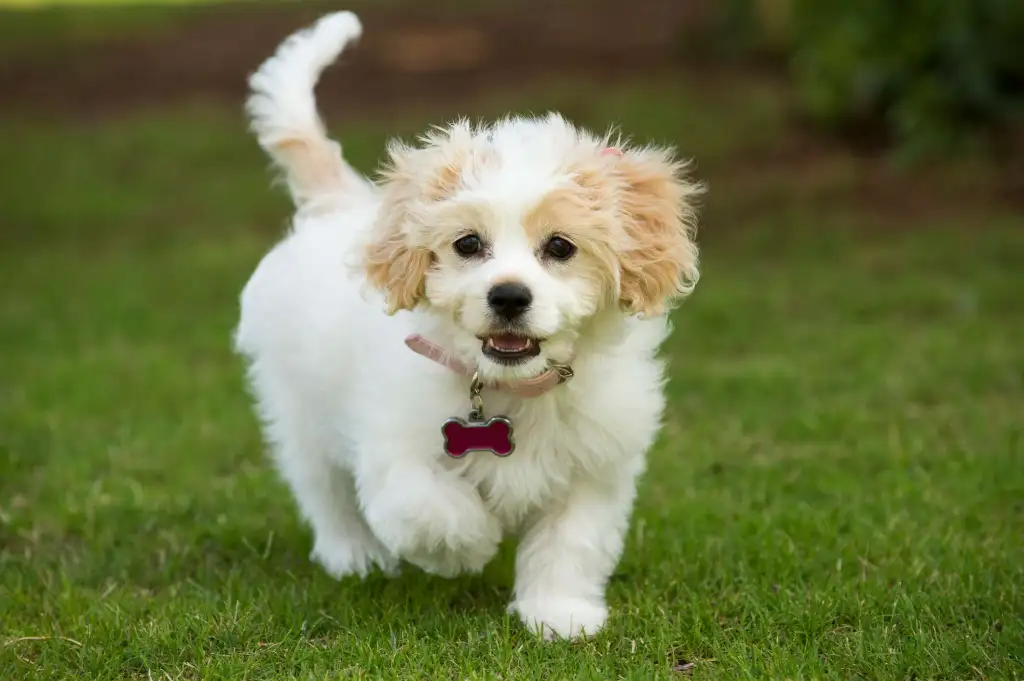
Cavachon history
This modern designer breed was first intentionally bred in the late 1990s in the United States, primarily to combine the most desirable traits of both parent breeds, particularly their affectionate, gentle nature and hypoallergenic coat. While the Cavachon is relatively new, their parent breeds have a long and storied history.
The Cavalier King Charles Spaniel dates back to the 16th century in England, where they were favored by royalty, including King Charles I and King Charles II. Originally bred as lap dogs and companions for aristocrats, the Cavalier is known for its sweet temperament, loyalty, and silky, flowing coat. Their affectionate and gentle nature also made them ideal companion animals for noble families.
The Bichon Frise is believed to have originated in the Mediterranean region, where they were popular among sailors. Later, they became the favored pets of European nobility, especially in Spain, France, and Italy. The Bichon Frise is known for their cheerful, playful personality and hypoallergenic, curly coat, which sheds minimally.
Cavachon personality
Cavachons are known for their affectionate, friendly, and gentle personalities. They also form strong bonds with their families and love being close to their humans. They often seek attention and affection, which makes them ideal companion dogs. However, they don’t fare well left alone for long periods and may be prone to separation anxiety.
While they enjoy lounging and cuddling, Cavachons also have a playful side. They like games, playtime, and short bursts of activity but are not overly high-energy, making them manageable for various living situations, including apartments. Cavachons are adaptable and can adjust to different living environments, whether in a small apartment or a larger home, as long as they receive attention, love, and moderate exercise.
Temperament and behavior
- Affectionate and Loving: Cavachons are highly affectionate and enjoy close bonds with their families, often seeking attention and affection.
- Friendly and Social: They get along well with people, children, and other pets, making them great family dogs and good in social environments.
- Playful but Not Overly Energetic: They enjoy playtime and games but are not overly hyper, making them well-suited for various living situations, including apartments.
- Adaptable: Cavachons adjust easily to different living environments and routines, whether in a small apartment or a larger home.
- Intelligent and Eager to Please: They are quick learners and respond well to positive reinforcement, making training easier.
- Gentle and Calm: Known for their mild temperament, they are well-mannered, easygoing, and rarely aggressive or stubborn.
- Low Barking Tendency: While they may alert their owners to visitors or unfamiliar noises, they generally don’t bark excessively.
Training and socialization
Early socialization and positive reinforcement training are crucial due to their intelligence and potential stubbornness. Of course, their intelligence allows them to pick up commands quickly, so early training is key to establishing good behavior from the start. Use praise, treats, and affection to reward desired behavior. Cavachons are sensitive and respond well to positive reinforcement.
Training tips:
- Be Consistent: Consistency is crucial in training. Use the same commands and routines to avoid confusion. This helps your Cavachon understand what is expected of them.
- Keep Training Sessions Short and Fun: Cavachons are intelligent but can lose interest if training sessions are too long or repetitive. Keep sessions short (10-15 minutes) and engaging with varied activities.
- Mental Stimulation: Incorporate puzzle toys, obedience training, and interactive games into their routine to challenge their mind. A bored Cavachon can become restless. Once basic obedience is established, teach more advanced commands or tricks. Their intelligence makes them excellent candidates for agility training, fetch, or scent games.
How long can the Cavachon be left alone?
Cavachons, like many companion dogs, tend to thrive on human interaction and can become anxious or bored if left alone for long periods. Generally, a Cavachon can be left alone for 4 to 6 hours at a time. However, leaving them alone for longer than this regularly can lead to separation anxiety, destructive behavior, or excessive barking.
Cavachon Care
As with all dogs, it’s important to keep up your Cavachon’s regular veterinary checkups to detect any health concerns early. Your vet can help you develop a care routine that will keep your dog healthy.
Cavachon grooming needs
Cavachons have moderate grooming needs due to their soft, often wavy or curly coats, which can be prone to matting and tangling. Regular grooming helps keep their coat healthy and looking their best.
How to groom a Cavachon
Grooming a Cavachon involves maintaining their coat, ears, nails, and teeth. Their grooming needs can vary depending on whether they inherit more of the Bichon’s plush, double coat or the Cavalier King Charles Spaniel’s wavy/straight coat.
Brushing and bathing:
- Brushing: Cavachons should be brushed at least 3 to 4 times a week to prevent tangles and mats from forming, especially if they have a curlier coat. For longer coats, daily brushing may be needed.
- Bathing: Bathing is recommended about once every 4 to 6 weeks or as needed to keep their coat clean and smelling fresh. Be sure to use a dog-friendly shampoo that’s gentle on their skin and coat.
- Trimming: Regular trims every 6 to 8 weeks can help maintain the coat’s length and shape. Many Cavachon owners choose to have their dogs professionally groomed to ensure the coat is evenly trimmed, especially around the face, paws, and tail.
Other grooming needs:
- Ears: Cavachons have floppy ears, which can trap moisture and dirt, increasing the risk of infections. Their ears should be checked and cleaned weekly to prevent wax buildup and infections.
- Teeth: Dental hygiene is important, so brush your Cavachon’s teeth 2 to 3 times a week to prevent plaque buildup and dental disease.
- Nails: Their nails should be trimmed every 4 to 6 weeks or as needed. If you can hear their nails clicking on the floor, it’s time for a trim.
- Eyes: Regularly check and wipe around their eyes to prevent tear staining, which is common in lighter-coated Cavachons.
Early acclimation is key
Getting your Cavachon accustomed to grooming procedures from a young age makes the process easier and more enjoyable for both of you. Handle their paws frequently, examine their mouth and ears, and reward them for good behavior during grooming sessions. This positive foundation sets the stage for stress-free veterinary exams and handling throughout their lives.
Feeding and nutrition
As with all dogs, the Cavachon’s dietary needs will change from puppyhood to adulthood and will continue to change into their senior years. You should ask your veterinarian for recommendations about your Cavachon’s diet, as there is far too much variation among individual dogs to make a specific recommendation.
Portion size:
- Adult Cavachons typically need around 1 to 1.5 cups of high-quality dog food per day, divided into two meals (morning and evening). The exact amount will depend on their weight, age, activity level, and metabolism.
- Puppies may require more frequent feedings, about three to four times a day, with smaller portions to support their growth.
- Treats should be given in moderation, accounting for less than 10% of their daily caloric intake. Opt for healthy, low-calorie treats, and avoid human foods that could be harmful to dogs (e.g., chocolate, onions, grapes).
High-quality dog food:
- Choose a premium, well-balanced dog food formulated for small to medium breeds. Look for food with high-quality animal proteins (such as chicken, turkey, or fish) listed as the primary ingredient.
- Avoid foods with excessive fillers, artificial additives, or by-products.
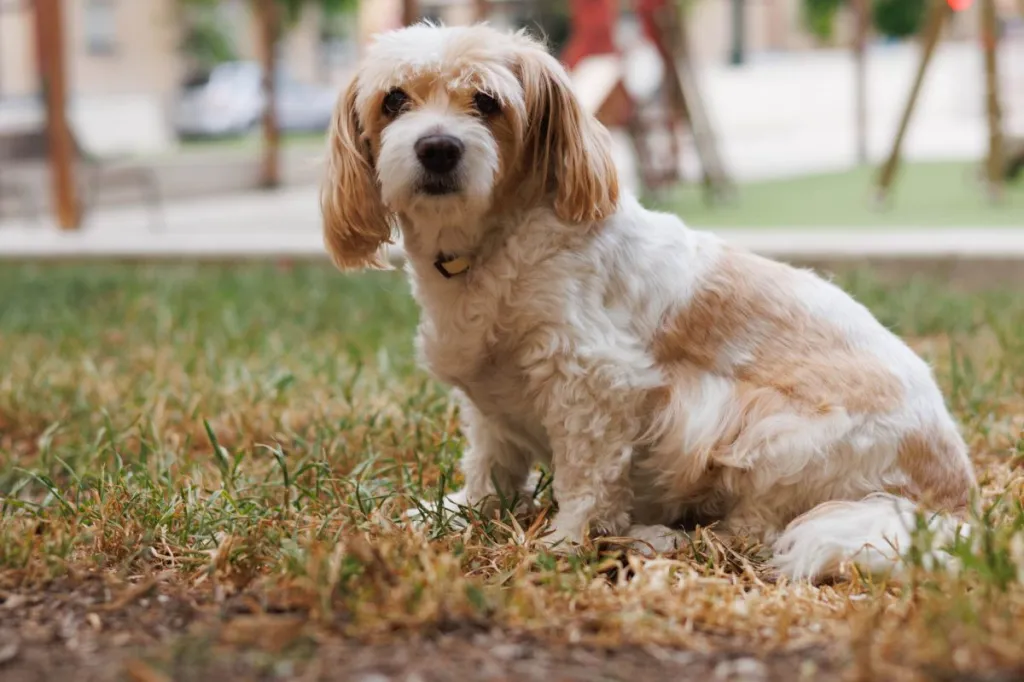
Cavachon and family compatability
Cavachons are highly compatible with families and make excellent pets for households with various dynamics. Additionally, their friendly, affectionate nature and moderate energy levels make them a great fit for families of all sizes, including those with children or other pets. The Cavachon is social and enjoys the company of other dogs, as long as they receive their fair share of attention from their owner. With proper introductions and training, the Cavachon can get along with cats and other animals.
As with every breed, you should always teach children how to approach and touch dogs and supervise any interactions between dogs and young children to prevent biting or ear or tail pulling on the part of either party. Teach your child never to approach any dog while it’s eating or sleeping or to try to take the dog’s food away.
Cavachon health issues
The Cavachon mixed breed is predisposed to some of the same conditions that the Cavalier and Bichon parents also face. While most are generally healthy, some may be prone to a few health issues, which is why it is important to maintain good care and regular veterinary checkups. Some of the more common health concerns to watch out for in Cavachons include:
- Mitral Valve Disease: Cavachons are prone to mitral valve disease, a condition affecting the heart’s mitral valve, which can lead to heart failure if not managed properly, requiring regular veterinary monitoring and medication to maintain cardiac function.
- Syringomyelia (SM): A severe, chronic condition that affects the spinal cord. When fluid-filled cavities or cysts — known as syrinxes — form within the central canal of the spinal cord, they can expand and cause damage to the spinal cord’s tissue. This process can lead to a variety of symptoms, ranging from mild discomfort to severe pain and partial paralysis. The condition is most commonly seen in certain toy breeds but can affect any dog.
- Atopic Dermatitis: Cavachons may experience atopic dermatitis, a skin condition characterized by inflammation and itching, often triggered by environmental allergens, requiring diligent skincare and potentially medication to alleviate symptoms.
- Cataracts: Like many small breeds, Cavachons can develop cataracts, a clouding of the eye’s lens, impairing vision and potentially leading to blindness, necessitating veterinary evaluation and surgical intervention if necessary.
- Patellar Luxation: Cavachons are susceptible to patellar luxation, a condition where the kneecap dislocates from its normal position, causing lameness and discomfort, often requiring surgical correction to restore proper joint function and mobility.
Cavachon rescue groups
It may be hard to find a breed-specific rescue for Cavachons because they are a mixed breed. However, you may want to try Cavalier King Charles Spaniel or Bichon Frise breed-specific rescues, as they often care for mixes, as well. Here are some rescues you can try:

